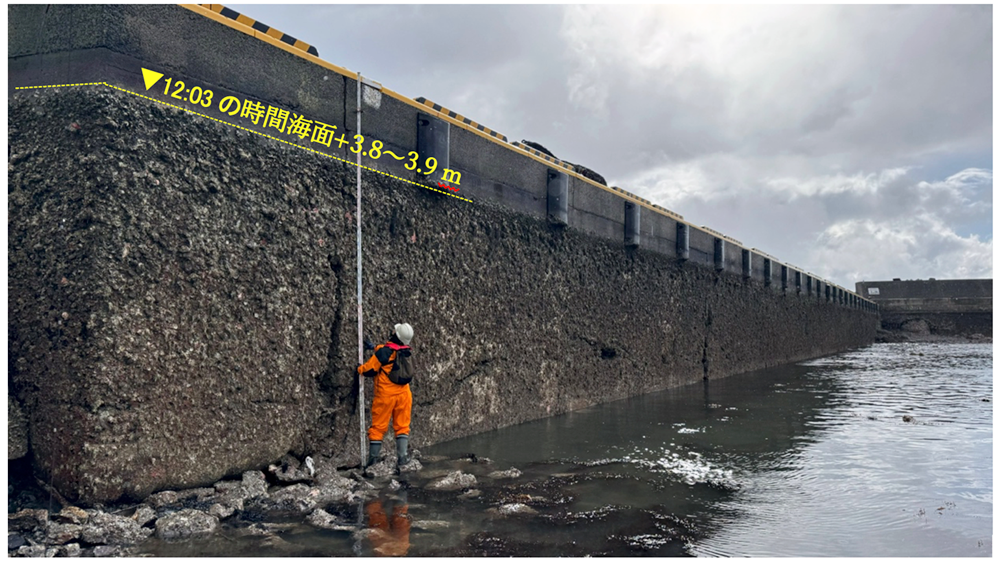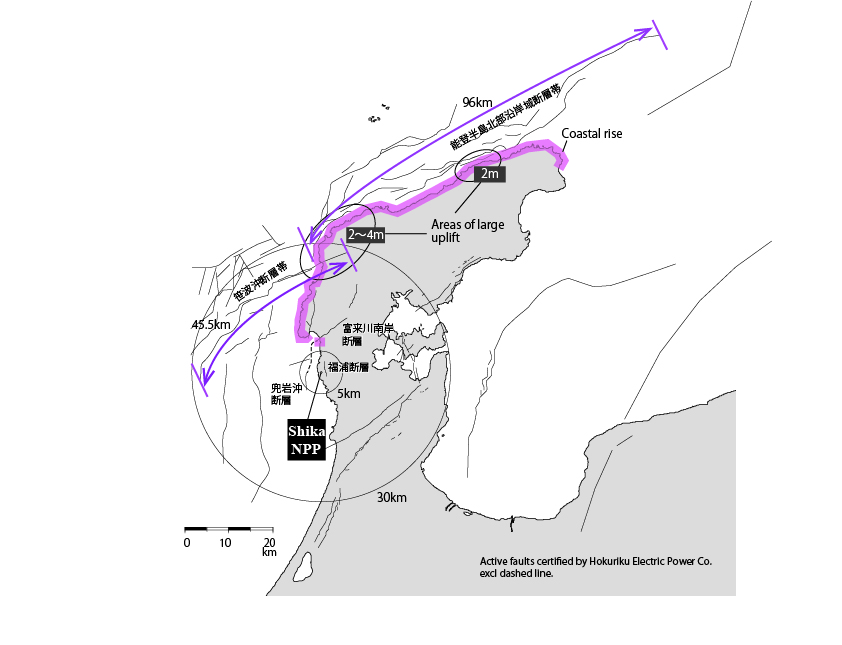The 2024 Noto Peninsula Earthquake and Shika Nuclear Power Plant
By Kamisawa Chihiro (CNIC)
The 2024 Noto Peninsula Earthquake
At 16:10 on January 1, a severe, magnitude (Mj – Japan Meteorological Agency magnitude scale), 7.6 earthquake occurred on the Noto Peninsula on the northern side of central Honshu, Japan. Since the earthquake was caused by active faults moving along the coastline seafloor, a tsunami with a maximum wave height of over three meters also occurred.
In Suzu City, Wajima City, and Anamizu Town, close to the epicenter of the earthquake, more than 13,000 houses were completely or partially destroyed by the violent shaking, and more than 230 people lost their lives, mostly trapped under damaged buildings. More than 1,000 people were also injured.
The damage to buildings caused by the earthquake extended not only to Ishikawa Prefecture, where the Noto Peninsula is located, but also to Toyama Prefecture, Niigata Prefecture, Fukui Prefecture and Nagano Prefecture. In particular, many buildings were destroyed by ground liquefaction in Niigata City, more than 160 kilometers from the epicenter. Over the whole Hokuriku region, more than 20,000 buildings were severely damaged, being totally or partially destroyed, and a total of about 85,000 buildings were at least partially damaged.

In the mountainous Noto Peninsula, landslides and mudslides occurred in many places, road closures occurring everywhere, including on large arterial roads. Many settlements were thus cut off from the outside, leaving nearly 4,000 people isolated and unable to receive any relief at all.
Massive ground elevation occurred on the land side along the coastline seafloor active fault. The whole coast, about 95 kilometers, along the north side of the Noto Peninsula rose, many ports becoming shallow or landlocked, making it impossible for ships to enter or leave. Surveys at the site show that the ground was elevated up to four meters in Wajima City in the northwest of the Noto Peninsula.
Aftershocks continued to occur (there were 570 aftershocks exceeding Mj3.5 up to February 29), the epicenters of which extended approximately 150 kilometers in an east-west direction, not only around the epicenter of the main shock.
Freezing of Construction of Suzu Nuclear Power Plant and Shutdown of Shika Nuclear Power Plant
The Suzu Nuclear Power Plant (NPP) was once scheduled to be built near what has now become the epicenter of the earthquake. In 2003, however, as a result of strong opposition by local residents, Kansai Electric Power and Chubu Electric Power Co. announced the freezing of the planned construction of the NPP, and there is thus no NPP there now. If the Suzu NPP had been built, it is highly likely that the plant would have been destroyed by the earthquake, leading to a catastrophic nuclear disaster.
The Hokuriku Electric Power Company Shika NPP is located about halfway up the western coast of the Noto Peninsula, about 70 kilometers from the epicenter of the main shock. A large tremor struck the Shika Nuclear Power Plant, an acceleration of about 400Gal (=400 cm/s/s) being recorded on the floor of the second basement level of the Unit 1 reactor building. The intensity of the tremor was such that if the nuclear power plant had been in operation, it would have greatly exceeded the set value for an emergency shutdown of the reactor, and it would have been necessary to shut down the reactor immediately. Even if an emergency automatic shutdown signal occurs, it is not known whether the control rods would insert into the reactor core as expected in the violent shaking. Assuming the reactor shut down without any problems, the reactor core would then have to be cooled, and if power and cooling water were lost, the result would be a severe accident such as occurred at the Fukushima Daiichi Nuclear Power Station.
It was indeed fortunate that both Units 1 and 2 had been shut down since March 2011, eliminating concern about an emergency shutdown at the Shika NPP. The need to cool the highly calorific reactor cores immediately after the shutdown was thereby avoided.

Damage Situation at Shika NPP
However, it is reported that the earthquake caused various kinds of damage at the Shika NPP.
The most dangerous place in the NPP is the spent fuel pool (SFP), into which all the fuel assemblies from the reactor have been moved. Immediately after the earthquake, the Unit 1 fuel pool cooling and filtering system pump stopped automatically and was restarted about 40 minutes later. There was little change in the temperature of the water in the SFP due to the short stoppage time of the pump and the low heat generation of the spent fuel, but the situation could have been more serious if the pump stoppage time had been much longer.
Piping was damaged in the Unit 1 startup transformer and the Unit 2 main transformer. A total of about 24,000 liters of insulating oil leaked from the two transformers, some of which spilled into the sea. As there was a temporary inability to receive outside electric power, the system was switched over to a standby transformer. As a result, three out of a total of five power lines were disabled. The transformer has not yet been restored.
It is also known that a tsunami of about three meters in height arrived about 90 minutes after the earthquake. It has been reported that fissures and deformations appeared in several locations in onsite roads and building foundations. A geological structure suspected to be an active fault exists under the buildings on the site, and it is necessary to investigate in detail the relation between this and the reported trouble.
Damage to Shika Nuclear Power Plant
White lines indicate suspected active fault lines.
Aerial photo supplied by the Geospatial Information Authority of Japan
www.gsi.go.jp/BOUSAI/20240101_noto_earthquake.html <www.gsi.go.jp/BOUSAI/20240101_noto_earthquake.html>
Defenseless Against an NPP Disaster
A number of problems directly affecting the safety of NPPs have been revealed, such as the occurrence of a severe earthquake due to the simultaneous and associated movements of multiple active faults, the possibility of the destruction of buildings and structures, as well as the inability to pipe in water for cooling likely to occur from ground uplift, and the possibility of the destruction of facilities due to the activity of small secondary faults onsite. In addition, monitoring posts installed by the local government as a monitoring system in the event of an accident did not function, evacuation roads collapsed, and, once again, it became clear that everything imaginable and more will happen in an NPP accident set off by an earthquake.

